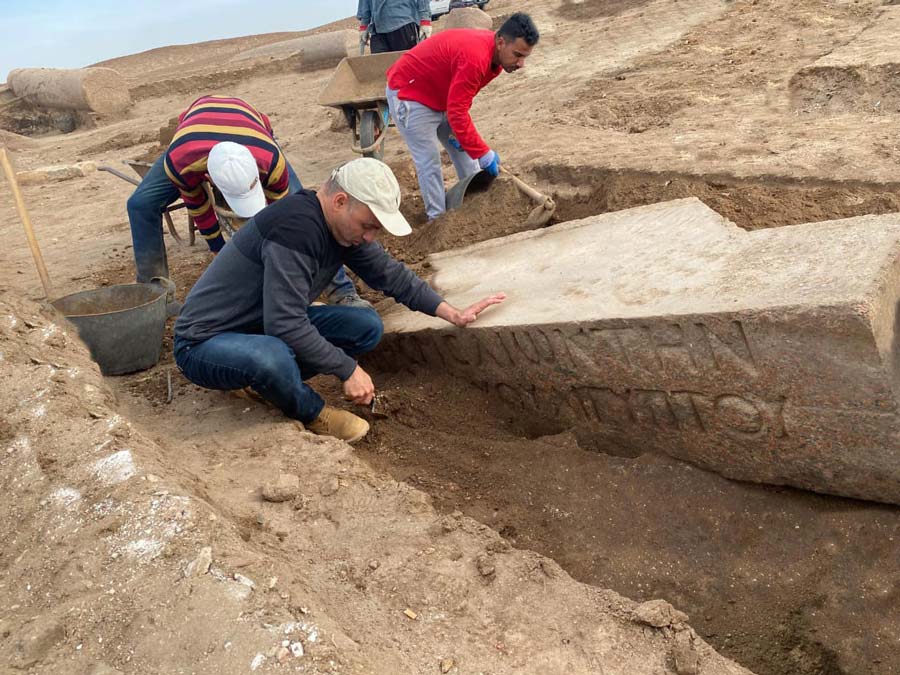Ancient Zeus Kasios Temple Unearthed In Egypt
Archaeologists in Egypt have excavated a vast temple built by members of the mysterious cult of Zeus Kasios.
The Egyptian Tourism and Antiquities Ministry announced on Monday that archaeologists have unearthed a temple dedicated to the ancient Greek god Zeus Kasios. This oriental god was connected with Mt. Casius, where Zeus the Greek Sky God once worshiped.
The crumbling stone pillars were excavated at the Tell el-Farma archaeological site in the northwestern corner of the Sinai Peninsula. Tell el-Farma is often known by its ancient name Pelusium, which dates back to the late Pharaonic period (525-332 BC). However, this temple site was later reused during Greco-Roman and Byzantine times.
- Rosetta-style engraving lauding Cleopatra I and two Ptolemaic Pharaohs unearthed in Egypt
- What Happened to Grand Temple Building in Ancient Egypt after the Death of Alexander the Great?

The site of the Zeus Kaisos temple. (Egyptian Ministry of Tourism and Antiquities)
A Vibrant Ancient Fortified Border City
Pelusium was an important city and border-fortress on a wild frontier, protecting Egypt from both the sea and Syria. Located in the eastern extremes of Egypt's Nile Delta, about two-and-a-half miles from the sea, the city is about 30 km to the southeast of the modern Port Said. This ancient population center would later become a Roman provincial capital and Metropolitan archbishopric. And while this was an ancient spiritual center, Pelusium is also known for being an early producer of fine craft beers.
According to Mostafa Waziri, secretary-general of Egypt's Supreme Council of Antiquities, the ruins were found between the Pelusium Fort and a memorial church at the excavation site. The site was first identified in the early 20th century by French Egyptologist Jean Clédat after he discovered ancient Greek inscriptions relating to the god Zeus-Kasios, said the Ministry. And since then several other inscriptions have been found in the area detailing Roman Emperor Hadrian renovating the cult temple.
- Decrypting the Temple of Edfu and the Edfu Texts
- Were These Eunuchs in Ptolemaic-Roman Egypt? The Truth May Be in Their Bones

The ruins include two large stone columns as part of the entrance gate, shown here. (Egyptian Ministry of Tourism and Antiquities)
Excavating A Grand Zeus Kaisos Temple Entrance
The team of archaeologists who excavated the temple ruins first pinpointed its grand entrance gate. Two huge granite columns had fallen down when the gate collapsed during ‘a powerful earthquake ’, according to the ministry. The researchers also found a set of large granite blocks that they believe were probably installed in an elaborate staircase which worshipers would climb to the temple entrance.
Hisham Hussein, the director of Sinai archaeological sites, said the team of archaeologists will not only study the unearthed blocks up close, but that a greater research team is now planning to conduct a full photogrammetry survey. Photogrammetric surveys establish targeted photo control on the surface of the ground. These images are compared to ultra-high resolution aerial photographs. Therefore, the temple ’s horizontal and vertical datums can be analyzed to help the archaeologists determine its original architectural design.

The site includes granite columns and inscribed blocks. (Egyptian Ministry of Tourism and Antiquities)
An Important Cult Center For Worshiping Zeus Kasios
Many popular Egyptian cults spread abroad, and we often read about temples of Isis being excavated in a Roman context as a mystery religion. Furthermore, the god Serapis (Osiris-Apis) who was worshiped widely by distant cultures in non-Egyptian iconography and language. Lesser known is the cult of Zeus Kasios in ancient Egypt, but it is widely referenced in a number of historical sources dating from the Classical to the Arabian Period. According to scholar Alexandra Oliveira, at Kasion there would have been 'one of the most important cult centers to this divinity.’ While many temples are dedicated to the god Zeus Kasios, none of these sources agree about the accurate location of the mystic mount.
It is generally agreed, however, that the word ‘Kasios’ came from the Hurrian mount Hazzi and ancient Greek sources refer to it as ‘the main cult center in the Ptolemaic Period’ according to writer Olivera.
The Zeus Kasios cult was also functional in Corcyra, Syria and on the Iberian Peninsula around cape Palos and cape Saint Vincent. This newly excavated temple will not only serve as a boost to the local tourist economy, but it gives the team of archaeologists a great chance to test a range of new photogrammetric techniques.
Top image: Archaeologists excavating a large, engraved granite block at the Zeus Kasios temple at Tell el-Farma, Egypt. Source: Egyptian Ministry of Tourism and Antiquities
By Ashley Cowie



















